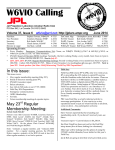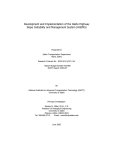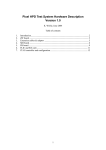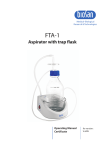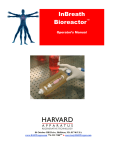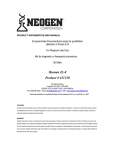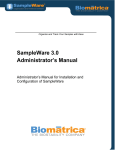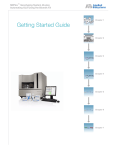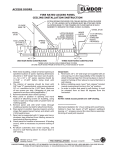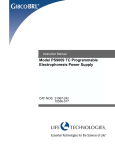Download PCR* Kits For DNA Ladder Assay
Transcript
PCR* Kits For DNA Ladder Assay (Cat. #: APO-DNA1) INSTRUCTION MANUAL *The Polymerase Chain Reaction (PCR) process is covered by patents owned by Hoffman-LaRoche. Use of the PCR process requires a license. A license for diagnostic purposes may be obtained from Roche Molecular System. A license for research may be obtained by the purchase and the use of authorized reagents and DNA thermocyclers from the Perkin-Elmer Corporation or by negotiating a license with Perkin-Elmer. This product is intended for research use only and not for diagnostic purposes. MBI Maxim Biotech, Inc . 780 Dubuque Avenue So. San Francisco, CA 94080 U.S.A. Feb., 2000 Tel: (800) 989-6296 Fax: (650) 871-2857 Website: http://www.maximbio.com APO-M10000001 1 INTRODUCTION The DNA Ladder Assay PCR Kit (LA-PCR, Cat #: APO-DNA1) is designed for the detection of nucleosomal ladders in apoptotic cells. Based on ligation-dependent PCR (Staley et al., 1997), this kit enables researchers to visualize ladders that are undetectable by other methods. Moreover, the PCR assay is semiquantitative, allowing comparison of the relative extent of apoptosis in different samples. During apoptosis, cellular endonucleases cleave genomic DNA between nucleo-somes, producing fragments whose lengths vary by multiples of 180–200 bp (Wyllie, 1980; Arends et al., 1992). When resolved by agarose/EtBr gel electro-phoresis, these DNA fragments appear as a “nucleosomal ladder”—a widely recognized hallmark of apoptotic cell death (Hale et al., 1996). Traditionally, such ladders have been assayed by electrophoresing genomic DNA samples directly on agarose/EtBr gels. However, in biological systems in which only a small percentage of cells are apoptotic, or in which apoptosis is occurring asynchro-nously, genomic DNA ladders may not be visible or appear as a smear. The PCR assay uses PCR to specifically amplify the nucleosomal ladder, making it easier to visualize. Figure 1 shows how the DNA Ladder Assay PCR works. The first step is the ligation of dephosphorylated adaptors (composed of a 12-mer and a 27-mer) to the ends of the DNA fragments generated during apoptosis. In mammalian cells, such fragments generally have 5'-phosphorylated blunt ends (Staley et al., 1997); thus, only the 27-mer is ligated to the DNA fragments. When the mixture of ligated DNA fragments is heated, the 12-mer is released. Next, the 5' protruding ends of the molecules are filled in by a thermostable DNA polymerase. The 27-mer then serves as a primer in a PCR in which the fragments with adaptors on both ends are exponentially amplified. The resulting nucleosomal ladder can be easily visualized on an agarose/EtBr gel. High sensitivity and low background Because of its high sensitivity, the DNA Ladder Assay PCR reveals ladders that may be undetectable by the conventional method. The nucleosomal ladder could not be detected when same genomic DNA as from Figure 1 was directly electrophoresed on the gel (data not shown). The DNA Ladder Assay PCR assay is semiquantitative. By comparing the numbers of PCR cycles needed to detect ladders in two samples, the relative amount of apoptosis occurring in each sample can be estimated. The DNA Ladder Assay PCR Kit includes optimized reagents for performing this assay. The kit includes T4 DNA Ligase, buffers, PCR primers, controls, and a complete User Manual. However, the thermostable DNA polymerase is not included. 2 continue adaptor 27-mer HO- genomic DNA fragment 5' adaptor 3' -OH HO-P HO5' -OH PHO-OH HO12-mer 3' -OH -OH Ligate adaptor to DNA fragments Heat to release 12-mer Fill in ends with thermostable DNA polymerase Amplify by PCR (30–35 cycles) Resolve amplified fragments on agarose/EtBr gel kb M 1 2 1,000 800 600 400 200 Figure 1. Schematic diagram of the PCR assay. For the gel shown here, apoptosis was induced in Keratinocyte cells by incubation with 10uM CPT for 6 hr. Genomic DNA was isolated from uninduced and induced Keratinocytes and was used in the PCR assay according to the User Manual (30 PCR cycles). The optimal number of PCR cycles must be determined for each genomic DNA sample. 11 µl of each reaction was electrophoresed on a 1.5% agarose/EtBr gel. Lane 1: uninduced. Lane 2: induced (apoptotic). Lane M: 100 bp DNA ladder markers. GENERAL CONSIDERATION • For genomic DNA isolation, we recommend the protocol described in Ausubel et al. (1994) or purchase Maxim's DNA isolation kit (Cat #: EXT-0001). For best results, use ~0.5 ug of genomic DNA for each ligation. We recommend that you do not use less than 0.25 ug of genomic DNA. • The PCR conditions in this protocol have been optimized using a Perkin-Elmer DNA Thermal Cycler 2400. The actual number of cycles performed will vary and must be determined empirically for each genomic DNA sample. • Add enzymes to reaction mixtures last, and thoroughly incorporate the enzyme by gently pipetting the reaction mixture up and down. "Hot start" PCR is highly recommended for LA-PCR, which can be achieved by adding Taq Pol. at 72C. 4 MATERIALS AND REAGENTS APO-DNA1: 50 test DNA Ladder Assay PCR (LA-PCR) Kit Each PCR Amplification/Detection Kit contains the following reagents and materials: Catalog No. Kit Component Amount Storage 250 µl 25 µl 250 µl 50 µl 1250 µl 250 µl N/A N/A DNA1-ADP DNA1-C001 DNA1-B001 DNA1-P001 10X Ligation Buffer T4 DNA Ligase (400 units/ul) 10X Adaptors 10X Pos. Control DNA 2X LA-PCR Buffer 10X Adaptor PCR Primers MRB-0014 N/A DNA M.W. Marker (100bp Ladder) 100 µl 2.0 ml ddH2O (DNase free) Instruction Manual 1 copy -20°C -20°C -20°C -20°C -20°C -20°C -20°C -20°C ADAPTOR 12-nt oligonucleotide: 5' AGT CGA CAC GTG 3' 27-nt oligonucleotide: 5' GAC GTC GAC GTC GTA CAC GTG TCG ACT 3' ADAPTOR PRIMER 27-nt oligonucleotide: 5' GAC GTC GAC GTC GTA CAC GTG TCG ACT 3' Materials Not Included: Product Taq DNA Polymerase Description Product Perkin-Elmer or it's equivalent recommended Description Agarose Gel 1-2-% Timer Electrophoresis Apparatuus Phenol Chloroform TE Buffer TBE Buffer Forceps Oven(s)or incubator(s) Pipettes and tips or it's equivalent recommended Set Tm. to 37 °C & 42 °C P1000, P200 and P20 NOTE: SPIN ALL TUBES BEFORE USING!! 5 PROCEDURE 1. Extract genomic DNA from tissue or cells of interest. Resuspend DNA in PCR-grade H 2 O or TE. Note: RNase treatment is not necessary, as residual RNA will not interfere with this procedure. However, treatment with DNase-free RNase and reprecipitation is necessary. if you are using UV spectrophotometry (OD 260 ) to quantify DNA. Be sure to wash DNA thoroughly to remove salts that will inhibit the ligation reaction. 2. Mix ~0.5 ug of genomic DNA with Ligation Buffer, Adaptor etc, 10X Ligation Buffer Genomic DNA or Control DNA (10X) Adaptors (10X) ddH2O 5 ul 5 ul 5 ul 34.5 ul If you use more or less than 0.5 ug of genomic DNA, you will need to adjust the volume of Ligation Mix. Overlay sample with mineral oil. 3. Heat reaction mixture to 55°C for 10 min; flick tube to mix. 4. Allow the adaptor oligonucleotides to anneal by cooling to 10°C over approximately 1 hr. Note: This gradual temperature ramp-down may be programmed into a thermal cycler for convenience. 5. Incubate reactions at 10°C for at least 10 min, then add 0.5 ul of T4 DNA Ligase. Make sure the ligase is thoroughly suspended before pipetting. 6. Incubate reactions at 16°C for 12–16 hours (overnight). Adaptor-ligated DNA may be stored at –20°C until needed for PCR. 7. Calculate the concentration of DNA in your ligation reactions using the following formula: Quantity of DNA (in ng) Volume of Ligation Mix (ul) + Volume of DNA added in step 2 (ul) From this value (in ng/ul), calculate the volume necessary to obtain the amount of adaptor-ligated DNA for PCR. The amount of adaptor-ligated DNA required for PCR may vary; we have found the optimal range to be 50–150 ng. However, we have obtained ladders with as little as 10 ng of DNA, albeit with much lower intensity. 8. For each LA-PCR sample, prepare a PCR mixture as follows: per rxn 2X LA-PCR Buffer 25 ul (containing chemicals, enhancer, stabilizer and dNTPs) PCR-grade H 2 O 9 ul Adaptor Primer (10X) 5 ul Adaptor-ligated DNA (50–150 ng) 10 ul Taq DNA Polymerase (5 U/ul)* 1 ul Total volume 50 ul *: It is necessary to use one of "Hot start" PCR methods, which can be achieved by heating above mixture without Taq Pol. at 72C for 2min and then add Taq Pol. 9. Overlay with 50 ul of mineral oil (if necessary). 6 PROCEDURE 10. PCR thermocycle profile: Reaction profiles will need to be optimized according to the machine type and needs of user. Please take note that temperature variations occur between different thermocyclers, therefore, the annealing temperature in the sample profile below is given as a range. It will be necessary to determine the optimal temperature for your individual thermocycler. An example of a time-temperature profile for the positive control PCR reaction optimized for Perkin Elmer machine types 480 and 9600 is provided below: Τ ime Temperature 72°C 94°C 10' 1' 94°C 1' 70°C 2' 72°C 20°C 10' Soak Cycles 1X 1X 30-35X 1X 11. Electrophorese 10-15 ul of each above reaction is mixed with loading buffer and loaded on a 1.5-2 % agarose/EtBr gel. 7 TROUBLESHOOTING 1. LA-PCR AMPLIFICATION Observation Possible Cause Recommended Action 1.1. No signal or no ladder during amplification even using positive control provided in kit. 1.1a. The annealing temperature in thermocycler is too high. 1.1b. Dominant primer dimers. 1.1a. Decrease PCR annealing tempera ture 3-5oC gradually. 1.1b. Use any one of "Hot Start" PCR procedures. 1.2. Too many nonspecific bands. 1.2a. The annealing temperature in thermocycler is too low. 1.2b. Pre-PCR mispriming. 1.2a. Increase PCR anneal temperature 3-5oC gradually. 1.2b. Use any one of "Hot Start" PCR procedures. 1.2c. Clean DNA with Phenol/ Chloroform. 1.2c. DNA is interfering with LA-PCR 8 PRECAUTIONS AND STORAGE Storage 1. Store all LA-PCR Kit components at -20°C. Under these conditions components of the kit are stable for 1 year. 2. Isolate the kits from any sources of contaminating DNA, especially amplified PCR product. 3. Store all of components in detection kit at 2-8°C. Under these conditions components of the kit are stable for 1 year. 4. Do not mix LA-PCR kit components that are from different lots. Each lot is optimized individually. REFERENCES Arends, M. J., Morris, R. G. & Wyllie, A. H. (1990) Apoptosis: the role of the endonuclease. Am. J. Pathol. 13 6:593–608. Ausubel, F. M., Brent, R., Kingston, R. E., Moore, D. D., Sidman, J. G., Smith, J. A. & Struhl, K. (1994) in Current Protocols in Molecular Biology (Greene Publishing Associates and John Wiley & Sons, Inc., NY) Vol. 1, Ch. 2.2. Barnes, W. M. (1994) PCR amplification of up to 35-kb DNA with high fidelity and high yield from l bacteriophage templates. Proc. Natl. Acad. Sci. USA 91:2216–2220. Cheng, S., Fockler, C., Barnes, W. M. & Higuchi, R. (1994) Effective amplification of long targets from cloned inserts and human genomic DNA. Proc. Natl. Acad. Sci. USA 91:5695–5699. Hale, A. J., Smith, C. A., Sutherland, L. C., Stoneman, V. E., Longthorne, V., Culhane, A. C. & Williams, G. T. (1996) Apoptosis: molecular regulation of cell death. Eur. J. Biochem. 237:884. Iwata, M. (1996) Regulation of thymocyte apoptosis and positive selection. Nippon Rinsho 54:1753–1759. Kellogg, D. E., Rybalkin, I., Chen, S., Mukhamedova, N., Vlasik, T., Siebert, P. & Chenchik, A. (1994) TaqStart Antibody: Hotstart PCR facilitated by a neutralizing monoclonal antibody directed against Taq DNA polymerase. BioTechniques 16:1134–1137. Staley, K., Blaschke, A. J. & Chun, J. (1997) Apoptotic DNA fragmentation is detected by a semiquantitative ligation-mediated PCR of blunt DNA ends. Cell Death Diff. 4:66–75. Wyllie, A. H. (1980) Glucocorticoid-induced thymocyte apoptosis is associated with endogenous endonuclease activation. Nature 284:555–556. 9











